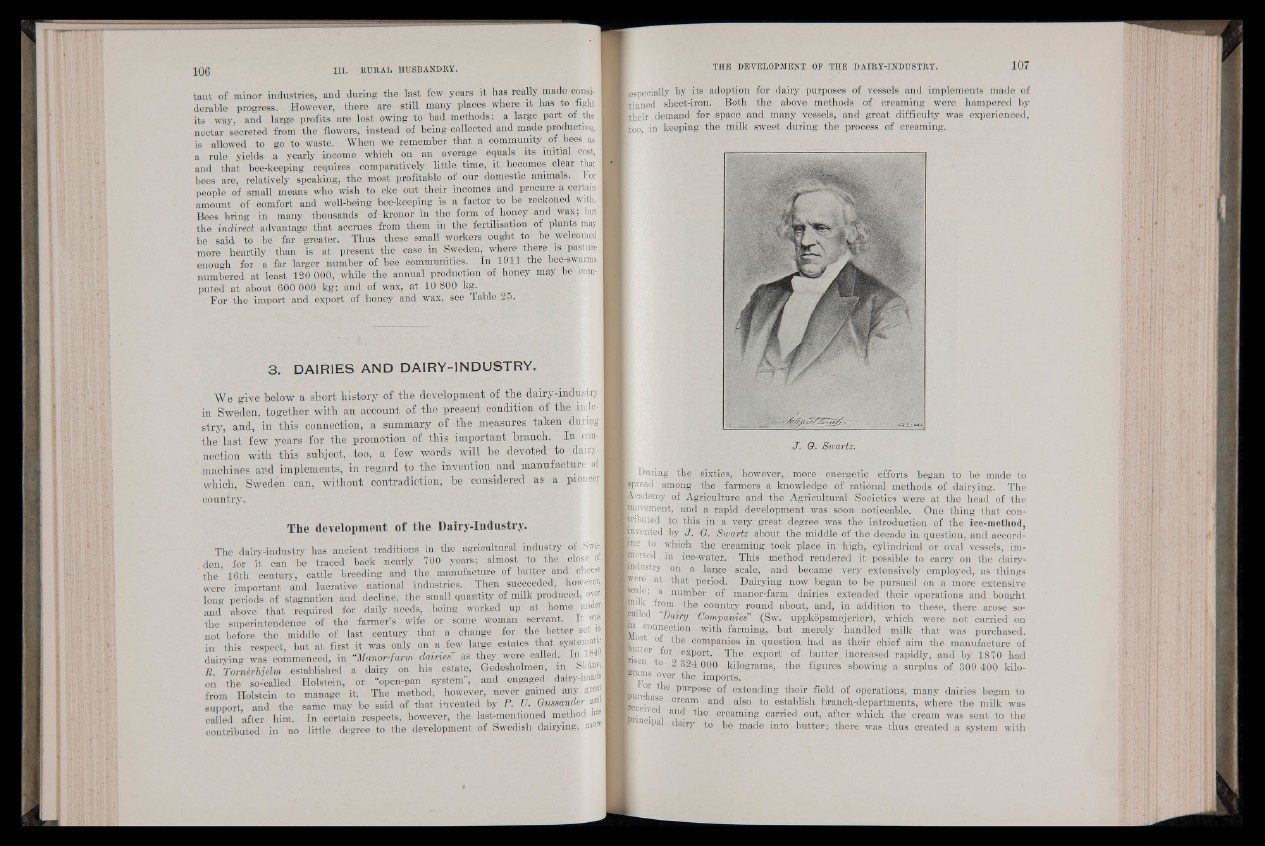
taut of minor industries, and during the last few years it has really made considerable
progress. However, there are still many places where it has -to fight
its way, and large profits are lost owing to bad methods: a large part of the
nectar secreted from the flowers, instead of being collected and made productive,
is allowed to go to waste. When we remember that a community of bees as
a rule yields a yearly income which on an average equals its initial .-cost,
and that bee-keeping requires comparatively little time, it becomes clear that
bees are, relatively speaking, the most profitable of our domestic animals. For
people of small means who wish to eke out their incomes and procure a certain
amount of comfort and well-being bee-keeping is a factor to be reckoned with.
Bees bring in many thousands of kronor in the form of honey and wax; but
the indirect advantage that accrues from them in the fertilisation of plants may
he said to be far greater. Thus these small workers ought to be welcomed
more heartily than is at present the case, in Sweden, where there is pasture
enough for a far larger number o f bee communities. In 1911 the bee-swarms
numbered at least 120 000, while the annual production of honey may be computed
at about 600 000 kg; and of wax, at 10 800 kg.
For the import and export of honey and wax, see Table 2.5.
3 . DAIRIES AND DA1RY-1NDUSTRY.
We give below a short history of the development of the dairy-industry j
in Sweden, together with an account of the present condition of the industry,
and, in this connection, a summary of the measures taken during
the last few years for the promotion of this important branch. iRcon-
nection with this subject, too, a few words will be devoted to dairy-
machines and implements, in regard to the invention and manufacture of j
which, Sweden can, without contradiction, be considered as a pioneer j
country.
The development of the Dairy-industry.
The dairy-industry has ancient traditions in the agricultural industry of Sweden"
for it can be traced back nearly 700 years; almost to the gpfese at,
th e ’ 16th century, cattle breeding and the manufacture of butter and cheese
were important and lucrative national industries. Then succeeded, however,
long periods of stagnation and decline, the small quantity of milk produced, over
and above that required for daily needs, being worked up at home ■ under
the superintendence of the farmer’s Wife or some woman servant. It was
not before the middle of last century that a change for the better se ®
in this respect, but at first it was only on a few large estates that system»
dairying was commenced, in “Manor-farm dairies” as they were called. In 1
B Tornerhjelm established a dairy on his estate, Gedesholmen, m bkafl%
on the so-called Holstein, or “open-pan system”, and engaged dairy-hana
from Holstein to manage it. The method, however, never gamed any gr»
support, and the same may be_ said of that invented by P. U. Qugsandei
called after him. In certain respects, however, the last-mentioned method
contributed in no little degree to the development of Swedish dairying, m01
[especially by its adoption for dairy purposes of vessels and implements made of
[tinned sheet-iron. Both the above methods of creaming were hampered by
their demand for space and many vessels, and great difficulty was experienced,
[too in keeping the milk sweet during the process of creaming.
■ During the sixties, however, more energetic efforts began to be made to
¡spread among the farmers a knowledge of rational methods of dairying. The
[Academy of Agriculture and the Agricultural Societies were at the head of the
jmovement, and a rapid development was soon noticeable. One thing that con-
pibuted to this in a very great degree was the introduction of the ice-method,
.invented by J. O. Swartz about the middle of the decade in question, and according
to which the creaming took place in high, cylindrical or oval vessels, immersed
in ice-water. This method rendered it possible to carry on the dairy-
pndustry on a large scale, and became very extensively employed, as things
pene at that period. Dairying now began to be pursued on a more extensive
|cale; a number of manor-farm dairies extended their operations and bought
t i l i k'.0m 111 cPnntry round about, and, in addition to these, there arose so-
called "Dairy Companies” (Sw. uppkopsmejerier), which were not carried on
■ connection with farming, but merely handled milk that was purchased,
■lost of the companies in question had as their chief aim the manufacture of
j .U ei *or export. The export of butter, increased rapidly, and by 1870 had
USen to; 2 324 000 kilograms, the figures' showing a surplus of 309 400 kilo-
Brams over the imports.
■ or the purpose of extending their field of operations, many dairies began to
fe cC' aSf cream and also to establish branch-departments, where the milk was
Brine 1 tl10 creamillg carried out,-, after which the cream was sent to the
I Clp dairy to be made into butter;; there was thus created a system with